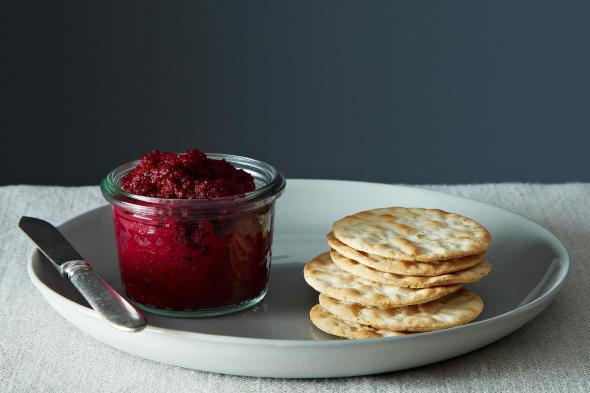Dinner vs. Child is a biweekly column about cooking for children, and with children, and despite children, originally published on Food52 and now appearing on Brow Beat.
Today: Nicholas spreads the brilliance of bright red beet hummus.
Beets, like math, are supposed to be hard. Not hard like broccoli, the sort of vegetable children supposedly hate, but hard like eggplant—an advanced vegetable, the sort of vegetable you need prerequisites for.
This is why when grown-ups see a child eating beets, they say exclamatory, disbelieving things, and if this child is yours, you can feel deeply superior, because you know, unlike these naïve people, that the only calories your child agreed to eat last night were those he found on the floor. (Foraging. It’s not just for the outdoors anymore.)
You see, beets are not hard. Beets are easy. (A beet on the floor: even easier.) All the available evidence suggests that the beetroot is a product of Willy Wonka’s factory. If anything, we should be surprised that adults eat it. To wit:
1) The beet is sweeter than any vegetable that does not contain the word “sweet.”
2) It is the only vegetable that is also a schlock horror movie special effect. Can you pretend you are standing over the carcass of your enemy, your fingers stained with deep red blood, while eating parsnips? You cannot. Do you still get dessert if you do this? Maybe.
3) Beets have predictable post-consumption consequences, which any non-anal-retentive preschooler finds hysterically gratifying every single time and enough of a reason to eat beets by itself. When I hear a squeal of delight from the bathroom, I know what has happened. (Usually.) This is very different from how adults react, which is more like: But this is the worst possible time for internal hemorrhaging! I have an interview in an hour! Next week would be fine for internal hemorrhaging, though. Can we reschedule this?
Unfortunately, Isaiah, who’s now “four and three-quarters” and wise to the ways of the world, seems to have absorbed the idea that beets are hard. After years of eating them—after years of taking him directly from the bloodied table to the sink—he’s decided that he’s never liked beets. This isn’t a surprise. He decides that he’s never liked things all the time. It’s like dining with an amnesiac: Every night, with complete conviction, he arrives at the table anew.

Photo by James Ransom
But Mila, who’s one-and-a-half and deaf to the ways of the world, still likes beets. Right now, in fact, he likes them with a certain amount of highly gestural, Jackson Pollack-like creative freedom. Adults throw things because they dislike them. Toddlers throw things because they like them. If you are short on adjectives, distance will do.
In short, if you find yourself feeding a toddler beet hummus, do not let him hold the spoon.
Let us pause here to acknowledge that beet hummus is not actually hummus. (People get uptight about this kind of thing.) But for better or worse, the word “hummus” has come into vogue: there is now a “hummus” recipe for seemingly every PLU in the produce department. (There’s the Internet. Go knock yourself out. I stopped after “apple hummus.”)
My beet hummus, which was inspired by Clotilde Dusoulier and Hugh Fearnley-Whittingstall, has no chickpeas. It does have some tahini, lemon, garlic, although my variation is light on those. It’s basically blitzed cooked beets, plus walnuts, with the flavors cranked up a bit. It goes well on toast, crackers, raw carrots, baby spoons. I have not yet tried it on beet chips.
Isaiah didn’t like it. Mila ate half the bowl.
Bright Red Beet Hummus
Inspired by Clotilde Dusoulier and Hugh Fearnley-Whittingstall. Adapt freely to your own likes or dislikes.
Makes a medium-sized bowl of hummus
1 pound cooked beets (I roast mine), quartered
¼ cup walnuts, toasted and roughly chopped
2 tablespoons lemon juice
½ tablespoon tahini
½ teaspoon ground cumin
1 garlic clove
1 tablespoon olive oil
½ teaspoon salt
See the full recipe at Food52.
Previously:
Why Can’t We Eat the Same Pumpkins We Carve?
Chicken Liver Pâté for Kids (Really)
Why Is Planning Dinner So Hard?
Why Do People Plant Berries They Can’t Eat?
How to Cook Dinner When a Small Child Is Dangling From Your Limbs
